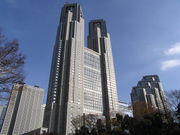Kenzo Tange
| Kenzo Tange | |
|---|---|
| Personal information | |
| Nationality | Japanese |
| Born | 4 September 1913 Osaka, Japan |
| Died | 22 March 2005 Tokyo, Japan |
| Alma mater | The University of Tokyo |
| Work | |
| Practice | 1946 Tange Laboratory 1961 The Urbanists and Architects Team Kenzo Tange Associates |
| Buildings | Hiroshima Peace Memorial Park, Plan for Skoplje, Tokyo Olympic Arenas, St Mary's Cathedral |
| Awards | RIBA Gold Medal, AIA Gold Medal, Order of Culture, Order of Sacred Treasures |
Kenzo Tange (丹下健三 Tange Kenzō, September 4, 1913 – March 22, 2005) was a Japanese architect, and winner of the 1987 Pritzker Prize for architecture. He was one of the most significant architects of the 20th century, combining traditional Japanese styles with modernism, and designed major buildings on five continents. Kenzo Tange was also an influential protagonist of the structuralist movement. He said: "It was, I believe, around 1959 or at the beginning of the sixties that I began to think about what I was later to call structuralism", (cited in Plan 2/1982, Amsterdam).
Influenced from an early age by the French modernist, Le Corbusier, he gained international recognition in 1949 when he won the competition for the design of Peace Memorial Park. Joining the group of architects known as Team X in the late 1950s he steered the group towards the movement that became Metabolism.
His University studies into urbanism put him in an ideal position for post war redevelopment. This was explored in designs for Tokyo and Skopje. His work influenced a generation of architects across the world.
Early life
Born on the 4 September 1913 in Osaka, Tange spent his early life living in Hankow and Shanghai before returning to Japan on the death of an uncle. In contrast to his green lawned, red brick life in Shanghai, the family moved into a thatched roof farmhouse in Imabari on the island of Shikoku.
After finishing middle school, he moved to Hiroshima in 1930 to attend High School. It was here that he first encountered work by the French modernist, Le Corbusier. Finding the drawings of the Palace of the Soviets in a foreign art journal set him on a course to become an architect. As a high school graduate he spent two years trying to get a place at university, during which time he read extensively about western philosophy and enrolled at the film division in the art department.
Tange started university in 1935 at the Department of Engineering of the University of Tokyo. He studied under Hideto Kishida and Shozo Uchida.[1] Although Tange was taken by the photographs of Katsura villa that sat on Kishida's desk, his own work was inspired by Le Corbusier. His graduation project was a seventeen hectare development set in Tokyo's Hibiya Park.[2]
Early career
Upon graduating Tange worked as an architect at the office of Kunio Maekawa. Whilst there he travelled to Manchuria in connection with a competition for the National Bank and returned via Japanese-occupied Jehol. At the onset of war he left Maekawa to become a postgraduate student at the Imperial University, where he remained until the Japanese surrender.
During this period of additional study he developed an interest in urban design, and using the only materials available to him in the library he embarked upon a study of Greek and Roman marketplaces.[3]
In 1942, Tange entered a competition for the design of the Greater East Asian Co-Prosperity Sphere Memorial Hall. He was awarded first prize for a design situated at the base of Mount Fuji that was a fusion of Shinto shrine architecture and the plaza on Capitoline Hill in Rome. The design was not realised. [4]
Tange became an assistant professor and opened Tange Laboratory in 1946.[5] In 1963, he was promoted to professor of the Department of Urban Engineering. As a professor, his students included Sachio Otani, Kisho Kurokawa, Arata Isozaki, and Fumihiko Maki.
Post war reconstruction
.jpg)
Tange's interest in urban studies put him in a good position for post war reconstruction. In the summer of 1946 he was invited by the War Damage Rehabilitation Board to put forward a proposal for certain war damaged cities and he submitted ones for Hiroshima and Maebashi. [6] His design for an airport in Kanon was later built, but a seaside park in Ujina was not. [7]
The Hiroshima authorities took a lot of advice about the city's reconstruction from foreign consultants and in 1947 Tam Deling, an American park planner suggested that a Peace Memorial be constructed and that bombed buildings situated near the hypo centre be preserved.[8] In 1949 the authorities enacted the Hiroshima Peace Memorial Reconstruction Act which gave the city access to special grant aid and in August that year an international competition was announced for the design of the Hiroshima Peace Memorial Park.[9]
Tange was awarded first prize for a design that proposed an axis through the park that intersected the Peace Boulevard and the atomic bomb dome. The museum was raised on massive piloti and framed the view along the axis.[10]
CIAM
On the strength of his competition win for Hiroshima Peace Memorial Park, Tange was invited by Kunio Maekawa to attend the Congres International d'Architecture Moderne (CIAM). Founded in 1928 this organisation of planners and architects had initially promoted architecture within its economic and social context, but at its fourth meeting in 1933 (under the direction of Le Corbusier) it debated the notion of the "Functional City". This led to series of proposals on urban planning known as "The Athens Charter". By the 1951 CIAM meeting that was held in Hoddesdon, England, to which Tange was invited, the Athens Charter became to be debated by the younger members of the group as "The Urban Core". Although the "Athens Charter" promoted the idea that the continual change of a city over many years gives a city its character it was written before the mass bombings or World War Two and therefore had little meaning for Tange in relation to Hiroshima.[11]
As he travelled back to Japan from England Tange visited Le Corbusier's nearly complete Unité d'Habitation in Marseilles, he also looked at the sketches for the new capital of the Punjab at Chandigarh.
At the tenth CIAM conference in Dubrovnik in 1956, younger members of the group reacted against the vagueness of the "Athens Charter" in relation to the reconstruction of cities. They formed a splinter group known as Team X which Tange later joined. The designs that he presented to their 1959 meeting in Otterlo, Holland included an unrealised project by Kiyonori Kikutake that would form the basis of the Metabolist Movement. [12]
Peace Centre in Hiroshima
Work on the Peace Centre commenced in 1950. In addition to the famous axial nature of the design, the layout is also similar to Tange's early competition arrangement for the Greater East Asian Co-Prosperity Sphere Memorial Hall.[13]
In the initial design the Memorial Museum was dominated by the adjoining utility buildings which were linked to it by high level walkways. Tange refined this to place the museum prominently at the centre, separated from the utility buildings (only one of which was subsequently design by him). In addition to its architectural symbolism he thought that it was important to have the bomb documentation central to the architectural design.[14]
The museum is constructed from bare reinforced concrete, the primary museum floor is lifted six metres above the ground on huge piloti and is accessible via a free standing staircase. The rhythmical facade comprises vertical elements that repeat outwards from the centre. Like the exterior, the interior too is finished with rough concrete, the idea was to keep this plain so that nothing could distract the visitor from the contents of the display.[15]
The Peace Plaza is the backdrop for the museum. The plaza was designed to allow 50,000 people to gather around the peace monument in the centre. Tange also designed the monument as an arch composed of two hyperbolic paraboloids, said to be based upon traditional Japanese Haniwa houses.[16]
The Ise Shrine


In 1953 Tange and the architectural journalist and critic Noboru Kawazoe were invited to attend the reconstruction of the Ise Shrine. The shrine has been reconstructed every 20 years and in 1953 it was the 59th iteration. Normally the reconstruction process was a very closed affair but this time the ceremony was opened to architects and journalists to document the event. The ceremony coincided with the end of the American Occupation and it seemed to symbolise a new start in Japanese architecture. In 1961 when Tange and Kawazoe published the book Ise: Prototype of Japanese Architecture he likened the building to a modernist structure: an honest expression of materials, a functional design and prefabricated elements.[17]
The Kagawa Prefectural Government Hall on the island of Shikoku was completed in 1958. Its expressive construction could be likened to the Daibutsu style seen at the Todai-ji in Nara.[18] The columns on the elevation only bore vertical load so Tange was able to design them to be thin, maximising the surfaces for glazing. Although it has been called one of his finest projects [19]it drew criticism at the time of its construction for relying too heavily on tradition.[20]
His own home designed in 1951 and completed in 1953 used a similar skeleton structure raised off the ground as the Hiroshima Peace Museum but fused it this time with more traditional Japanese design utilising timber and paper. The house is based upon the traditional Japanese module of the tatami mat, with the largest space flexibly designed so that it can be separated into three smaller rooms by fusuma sliding doors.[21] The facade is regulated into an a-b-a-a-b-a rhythm covered by a two tier roof. Kazuo Shinohara's 1954 house at Kugayama is remarkably similar in its design, although it is executed instead in steel and has a simpler rhythm to the facade.[22]
Tokyo World Design Conference and urban planning
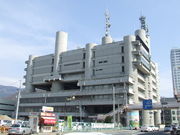
Tange had left the Team X Otterlo conference early to take up a tenure at Massachusetts Institute of Technology. His experiences at the conference may have led him to set the fifth year a project to design a 25,000 person residential community to be erected in Boston over the bay.[23] The scheme comprised two giant A-frame structures that resembled Tange's competition entry for the World Health Organisation's headquarters on Lake Geneva. Both this scheme and the earlier ones by Kikutake formed the basis of Tange's speech to the Tokyo World Design Conference in 1960. In his speech he used words such as "cell" and "metabolism" in relation to urban design. The Metabolist movement grew out of discussions with other members of the conference. Amongst them were Kisho Kurokawa, Junzo Sakakura, Alison and Peter Smithson, Louis Kahn, Jean Prouvé, B. V. Doshi and Jacob Bakema. The conference ended with Tange's presentation of the Boston plan and his own scheme, "The Tokyo Plan - 1960".[24]
Tange argued that in the world's mega cities, with populations greater than 10 million, the normal urban pattern of a radial centripetal transportation system was a relic of the Middle Ages that would be unable to adapt to the strain placed upon it. He argued that mobility determined the structure of a city.[25] Rather than the idea of a civic centre he proposed a civic axis, an axis that would develop in a linear fashion.[26]
Three levels of traffic, graded according to speed would facilitate the movement of up to 2.5 million people along the axis. The axis itself would be divided up into vertebrae-like cyclical transportation elements. The sheer size of the proposal meant that it would stretch out across the water of Tokyo Bay.[27]
Due largely to his proposals at this conference Tange became known as "The West's favourite Japanese architect". [28]
In 1965 Tange was asked by the United Nations to enter a limited competition for the redevelopment of the capital city of Macedonia Skopje. The town had been 65% destroyed by an earthquake in 1963. Tange won 60% of the prize with the other 40% awarded to the Yugoslav team. Tange's design had developed ideas put forward in the earlier "Tokyo Plan".[29] Unfortunately his proposals were only partially implemented, namely the New Skopje Railway Station and the so-called City Wall.
He further developed his ideas for expandable urban forms in 1966 when he designed the Yamanashi Broadcasting and Press Centre in Kōfu. It was designed for three media companies: a newspaper printing plant, a radio station and a television studio. To allow for future expansion Tange grouped the similar functions of three offices together in three zones. The newspaper printing machinery was on the ground floor, sealed studios on the upper floors and offices on glass walled floors with balconies running around. The services including stairs and lifts, are housed in 16 five metre diameter reinforced concrete columns. Space was left between the cluster of functional space to allow for future expansion, although these have been used for gardens and terraces.[30]
The Urbanists and Architects Team
Tange's inspiration for his design office came from his friend Walter Gropius who he had first met at the CIAM meeting in 1951. In his early work at the Bauhaus Gropius had placed great importance on teaching architects and those learning architecture as a profession working together as a team. The Urbanists and Architects Team was founded in 1961 and went onto form the present day Kenzo Tange & Associates. Tange promoted a very flat structure to the practice, partners had equal importance and were encouraged to participate in every project. Multiple options were developed simultaneously and research on individual schemes was encouraged.[31]
Town Hall, Kurashiki
The fortress-like town hall in Kurashiki was designed in 1958 and completed in 1960. When it was constructed it was situated on the edge of the old town centre connecting it with the newer areas of the town. Kurashiki is better known as a tourist spot for its old Machiya style houses.[32]
Set in an open square, the building sits on massive columns that taper inwards as they rise. The elevation is comprised of horizontal planks (some of which are omitted to create windows) which overlap at the corners in a "log cabin" effect. The entrance is covered with a heavy, projecting concrete canopy which leads to a monumental entrance hall. The stair to this hall ascends in cantilevered straight flights to the left and right. The walls to this interior are bare shuttered concrete punctured by windows reminiscent of Le Corbusier's La Tourette. The Council Chamber is a separate building whose raked roof has seating on top of it to form an external performance space.[33]
Tokyo Olympic Arenas
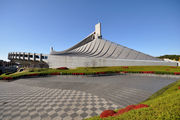
The Yoyogi National Gymnasium is situated in an open area in Yoyogi Park on an adjacent axis to the Meiji Shrine. The gymnasium and swimming pool were designed by Tange for the 1964 Tokyo Olympics which were the first Olympics to be held in Asia. Tange began designing in 1961 and the plans were approved by the Ministry of Education in January 1963. The buildings were laid out on site to optimise the space available for parking and to permit the smoothest transition of incoming and outgoing people.
Inspired by the skyline of the Colosseum in Rome, the striking roofs have a skin suspended from two masts. The buildings were inspired by Le Corbusier's Philips pavilion designed for Brussel's World Fair and Yale University hockey stadium designed by Eero Saarinen (both 1958). The roof of the Philips pavilion was created by complex hyperbolic paraboloid surfaces stretched between cables.[34] In both cases Tange took Western ideas and adapted them to meet Japanese requirements.
The Gymnasium has a capacity of approximately 16000 and the smaller building can accommodate up 5300 depending upon what events are taking place. At the time it was built it was the world's largest suspended roof span. Two reinforced concrete pillars support a prestressed steel net onto which steel plates are attached. The curvature of the roof helps protect it from the damaging effects of high winds. The concrete support system also carries the upper tier of seating.[35]
He won a Pritzker Prize for the design and the citation described it as "among the most beautiful buildings of the 20th century".[36]
Osaka Exposition 1970
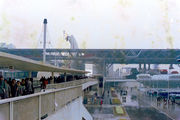
In 1965 it was decided that Japan should host the 1970 Exposition. 330 hectares of land in the Senri Hills near Osaka were put aside for its use. Tange and Uzo Nishiyama were appointed as planners for the masterplan by the Theme Committee. Tange assembled a group of twelve architects to design the infrastructure and facilities for the Expo.
At the centre of the Expo was the Festival Plaza. Tange conceived that this plaza (with its oversailing space frame roof) would connect the display spaces and create a setting for a "festival". The plaza divided the site into a northern zone for pavilions and a southern zone for administration facilities. The zones were interconnected with moving pathways.
Later Career
Although the Osaka Expo marked a decline in the Metabolist movement[37] and a handing over of the reigns to the younger generation such as Kazuo Shinohara and Arata Isozaki, Tange continued to practice until three years before his death. He disliked postmodernism in the 1980s and considered this architecture to be only "transitional architectural expressions".[38]
In the Tokyo Metropolitan Government Building in Shinjuku which opened in 1991, Tange designed a large civic centre with a plaza dominated by two skyscrapers. These house the administration offices whilst a smaller seven storey building contains assembly facilities. In a high tech version of Kofu Communications Centre Tange equipped all three buildings with state of the art building management systems that monitored air quality, light levels and security. The external skin of the building makes dual references to both tradition and the modern condition. Tange incorporated vertical and horizontal lines reminiscent of both timber boarding and the lines on semiconductor boards.[39]
In 2005, his funeral was held in one of his works, the Tokyo Cathedral.
Tadao Ando, one of Japan's greatest living architects, likes to tell the story of the stray dog, a stately akita, that wandered into his studio in Osaka some 20 years age, and decided to stay. "First, I thought I would call her Kenzo Tange; but then I realised I couldn't kick Kenzo Tange around. So I called her Le Corbusier instead." Kenzo Tange's obituary, Guardian Newspaper, 23 March 2005.
Guardian obituaries, retrieved 15 June 2010
Legacy
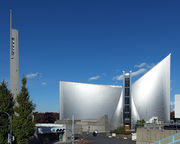
The modular expansion of Tange's Metabolist visions had some influence on Archigram with their plug-in mega structures.[40] The Metabolist movement gave momentum to Kikutake's career. Although his Marine City proposals (submitted by Tange at CIAM) were not realised, his Miyakonojo City Hall (1966) was a more Metabolist example of Tange's own Nichinan Cultural Centre (1962).[41]
In an interview with Jeremy Melvin at the Royal Academy of Arts, Kengo Kuma explained that, aged ten, he was inspired to become an architect after seeing Tange's 1964 Olympic arenas.[42]
For Reyner Banham Tange was a prime example of the use of Brutalism and his use of concrete had great influence on British architects in the 1960s.[43].
Tange's son Paul Noritaka Tange graduated from Harvard University in 1985 and went on to join Kenzo Tange Associates. He became the president of Kenzo Tange Associates in 1997 before founding Tange Associates in 2002.[44]
Selected projects
- 1955: Hiroshima Peace Memorial Museum, Hiroshima
- 1957: (Former) Tokyo Metropolitan Government Building, Yūrakuchō
- 1958: Kagawa Prefectural Government Building the east offices, Takamatsu, Kagawa
- 1960: Kurashiki City Hall, Kurashiki, Okayama
- 1964: Yoyogi National Gymnasium for the 1964 Summer Olympics, Tokyo
- 1964: St. Mary's Cathedral (Tokyo Cathedral) (Roman Catholic), Tokyo
- 1966: Master plan for rebuilding of Skopje, Republic of Macedonia, then part of Yugoslavia after the 1963 earthquake
- 1967: Towers of Fiera district (Regional administration of Emilia-Romagna), Bologna, Italy
- 1970: Site of Expo '70, Suita, Osaka
- 1970: Librino New Town Project [1] Catania City Italy
- 1977: Sogetsu Kaikan [2] Aoyama, Tokyo
- 1979: Hanae Mori Building, Aoyama, Tokyo
- 1982: Central Area New Federal Capital City of Nigeria, Nigeria
- 1986: Nanyang Technological University, Singapore
- 1986: OUB Centre, Singapore
- 1987: American Medical Association Headquarters Building, Chicago, Illinois, USA
- 1991: Tokyo Metropolitan Government Building, Shinjuku, Tokyo
- 1992: UOB Plaza, Singapore
- 1996: Fuji Television Building, Odaiba, Tokyo
- 1998: University of Bahrain, Sakhir, Bahrain
- 1998: WKC Centre For Health Development, Kobe, Hyōgo
- 2000: Kagawa Prefectural Government Building the main offices, Takamatsu, Kagawa
- 2000: Tokyo Dome Hotel
- 2003: The Linear - Private Apartments, Singapore
- 2005: Hwa Chong Institution Boarding School, Singapore
 1955: Hiroshima Peace Memorial Museum at the Peace Memorial Park of Hiroshima. |
1986: OUB Centre in Singapore |
1987: American Medical Association Headquarters Building, Chicago, United States |
 1992: UOB Plaza in Singapore |
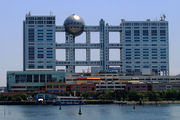 1996: Fuji Television Building in Odaiba, Tokyo |
 2000: Kagawa Prefectural Government Building main office |
Footnotes
- ↑ Stewart (1987), p170
- ↑ Stewart (1987), p171
- ↑ Stewart (1987), p171
- ↑ Reynolds (2001), p126
- ↑ Pritzker Prize:Biography, retrieved 13 March 2010
- ↑ Yorifusa (2003), p29
- ↑ Norioki (2003), p92
- ↑ Norioki (2003), p96
- ↑ Diedfendorf, Hein & Yorifusa (2003), p95
- ↑ Diedfendorf, Hein & Yorifusa (2003), p98
- ↑ Stewart (1987), p173
- ↑ Stewart (1987), p176, 177
- ↑ Stewart (1987), p175
- ↑ Kulterman (1970), p17
- ↑ Kulterman (1970), p18
- ↑ Kulterman (1970), p18
- ↑ Diedfendorf, Hein & Yorifusa (2003), p197
- ↑ Stewart (1987), p207
- ↑ Japan Architect (2005), p100
- ↑ Kulterman (1970), p56
- ↑ Kulterman (1970), p28
- ↑ Stewart (1987), p197
- ↑ Stewart (1987), p177
- ↑ Stewart (1987), p179-181
- ↑ Kulterman (1970), p119
- ↑ Kulterman (1970), p123
- ↑ Kulterman (1970), p128
- ↑ Stewart (1987), p182
- ↑ Kulterman (1970), p282
- ↑ Kulterman (1970), p246
- ↑ Kulterman (1970), p8
- ↑ Kulterman (1970), p92
- ↑ Banham (1978), p82
- ↑ Stewart (1987), p218
- ↑ Kulterman (1970), p204
- ↑ The Pritzker Architecture Prize, retrieved 15 June 2010
- ↑ Frampton (1990), p283
- ↑ Guardian obituaries, retrieved 15 June 2010
- ↑ Doordan (2002), p274
- ↑ Frampton (1990), p282
- ↑ Stewart (1987), p216
- ↑ Royal Academy of Arts, retrieved 16 June 2010
- ↑ Guardian obituaries, retrieved 15 June 2010
- ↑ Cityscape Asia, retrieved 16 June 2010
References
- Banham, Reyner (1978). Age of the Masters - A Personal View of Modern Architecture. Architectural Press.
- Diedfendorf, Hein & Yorifusa (2003). Rebuilding Urban Japan After 1945. Palgrave MacMillan.
- Doordan, Dennis P (2002). Twentieth Century Architecture. Calmann & King Ltd.
- Frampton, Kenneth (1990). Modern Architecture a Critical History. Thames and Hudson.
- Kultermann, Udo (1970). Kenzo Tange. Pall Mall Press.
- Reynolds, Jonathan M. (2001). Maekawa Kunio and the Emergence of Japanese Modernist Architecture. University of California Press. ISBN 0-520-21495-1.
- Stewart, David B (2002). The Making of a Modern Japanese Architecture, From the Founders to Shinohara and Isozaki. Kodansha International.
- Spring 2005, "Do_co,mo.mo Japan: the 100 selection", The Japan Architect, No57
External links
|
|||||
